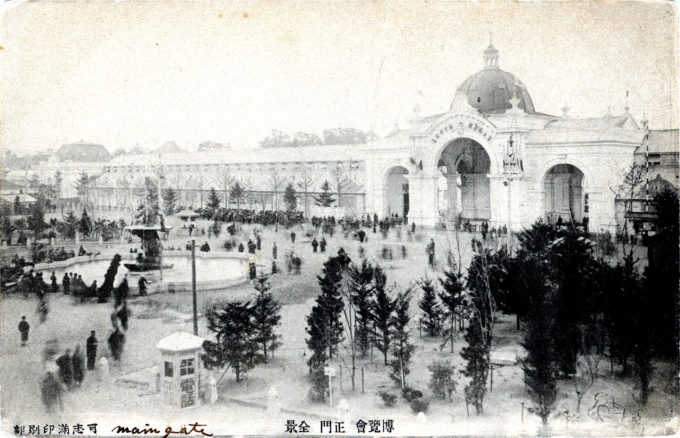“In the heart of Japan stands the great city, Osaka, which has the reputation of being the centre of the commerce and industry of the empire, and here, in 1903, all the provinces of the country will unite in holding a great exhibition to display the best products of all branches of industry.
“As is well known to foreign residents, and as is often attested by tourists, hospitality is second nature to the Japanese: everywhere strangers are received kindly and friendly, and in no part of the globe does travel become a source of greater pleasure.
“With open heart and out stretched hands we welcome our kind readers to a most interesting National Exhibition which will be formally opened to the public on March 1, and will close July 31, 1903, in the wealthiest city of Japan: Osaka.”
– Osaka and the Exhibition, published by Ichizo Miwa, 1903
See also:
Meiji (Tokyo) Industrial Exhibition, Ueno Park, 1907.
Osaka Electrical Exhibition, Osaka, 1926.
Tsutenkaku Tower, Osaka, c. 1930.
Rakutenchi amusement park, Sennichimae Osaka, c. 1920.
Expo ’70, Osaka, 1970.
“The Fifth National Industrial Exhibition was held in Osaka in 1903. It was the first to be open to foreign exhibitors, and twice the size of any previous National Industrial Exhibitions.
“The fair ran from March 1 through July 31, 1903, with formal opening by the emperor on April 20. It was held in the location now occupied by Tennōji Zoo, Tennōji Park. There were 4,350,693 visitors; 959,516 additionally visited the aquarium, which cost extra. This was the largest event held in Japan to date.
“The 47 Japanese prefectures all participated, as did 16 nations and colonies. Countries included Belgium, China, France, Germany, the United Kingdom, and the United States.
“There were a total of 153,799 exhibitors in a total of eighteen buildings. For those interested in fun, there was an off-site aquarium, an amusement park, and other entertainments including a theatre, a tower with a lift, a Mystery Building, and a two storey wooden Human Pavilion. The Aichi Prefecture building was built to look like a castle.
“The Formosan pavilion aimed to celebrate Japanese colonial rule, but it wasn’t of much interest to Japanese people. Two buildings were moved from the island to provide a shrine of Prince Kitashirakawa and a Bugaku dance stage.
“The buildings were destroyed after the fair, and the Tennōji Park established there.”
– Wikipedia


